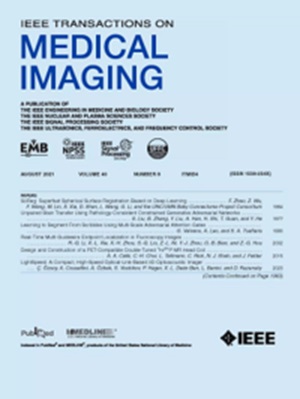A Dual-Attention Learning Network with Word and Sentence Embedding for Medical Visual Question Answering
IF 8.9
1区 医学
Q1 COMPUTER SCIENCE, INTERDISCIPLINARY APPLICATIONS
引用次数: 0
Abstract
Research in medical visual question answering (MVQA) can contribute to the development of computer-aided diagnosis. MVQA is a task that aims to predict accurate and convincing answers based on given medical images and associated natural language questions. This task requires extracting medical knowledge-rich feature content and making fine-grained understandings of them. Therefore, constructing an effective feature extraction and understanding scheme are keys to modeling. Existing MVQA question extraction schemes mainly focus on word information, ignoring medical information in the text, such as medical concepts and domain-specific terms. Meanwhile, some visual and textual feature understanding schemes cannot effectively capture the correlation between regions and keywords for reasonable visual reasoning. In this study, a dual-attention learning network with word and sentence embedding (DALNet-WSE) is proposed. We design a module, transformer with sentence embedding (TSE), to extract a double embedding representation of questions containing keywords and medical information. A dual-attention learning (DAL) module consisting of self-attention and guided attention is proposed to model intensive intramodal and intermodal interactions. With multiple DAL modules (DALs), learning visual and textual co-attention can increase the granularity of understanding and improve visual reasoning. Experimental results on the ImageCLEF 2019 VQA-MED (VQA-MED 2019) and VQA-RAD datasets demonstrate that our proposed method outperforms previous state-of-the-art methods. According to the ablation studies and Grad-CAM maps, DALNet-WSE can extract rich textual information and has strong visual reasoning ability.一种嵌入单词和句子的医学视觉问答双注意学习网络
医学视觉问答(MVQA)的研究有助于计算机辅助诊断的发展。MVQA是一项旨在根据给定的医学图像和相关的自然语言问题预测准确和令人信服的答案的任务。这项任务需要提取医学知识丰富的特征内容,并对其进行细粒度的理解。因此,构建一个有效的特征提取和理解方案是建模的关键。现有的MVQA问题提取方案主要关注单词信息,忽略了文本中的医学信息,如医学概念和特定领域术语。同时,一些视觉和文本特征理解方案不能有效地捕捉区域和关键词之间的相关性,从而进行合理的视觉推理。在本研究中,提出了一种具有单词和句子嵌入的双注意学习网络(DALNet-WSE)。我们设计了一个模块,带句子嵌入的转换器(TSE),来提取包含关键字和医疗信息的问题的双重嵌入表示。提出了一个由自我注意和引导注意组成的双重注意学习(DAL)模块来模拟密集的模式内和模式间交互。通过多个DAL模块(DAL),学习视觉和文本的共同注意可以增加理解的粒度并改进视觉推理。在ImageCLEF2019-VQA-MED(VQA-MED 2019)和VQA-RAD数据集上的实验结果表明,我们提出的方法优于以前最先进的方法。根据消融研究和梯度CAM映射,DALNet WSE可以提取丰富的文本信息,并具有较强的视觉推理能力。
本文章由计算机程序翻译,如有差异,请以英文原文为准。
求助全文
约1分钟内获得全文
求助全文
来源期刊

IEEE Transactions on Medical Imaging
医学-成像科学与照相技术
CiteScore
21.80
自引率
5.70%
发文量
637
审稿时长
5.6 months
期刊介绍:
The IEEE Transactions on Medical Imaging (T-MI) is a journal that welcomes the submission of manuscripts focusing on various aspects of medical imaging. The journal encourages the exploration of body structure, morphology, and function through different imaging techniques, including ultrasound, X-rays, magnetic resonance, radionuclides, microwaves, and optical methods. It also promotes contributions related to cell and molecular imaging, as well as all forms of microscopy.
T-MI publishes original research papers that cover a wide range of topics, including but not limited to novel acquisition techniques, medical image processing and analysis, visualization and performance, pattern recognition, machine learning, and other related methods. The journal particularly encourages highly technical studies that offer new perspectives. By emphasizing the unification of medicine, biology, and imaging, T-MI seeks to bridge the gap between instrumentation, hardware, software, mathematics, physics, biology, and medicine by introducing new analysis methods.
While the journal welcomes strong application papers that describe novel methods, it directs papers that focus solely on important applications using medically adopted or well-established methods without significant innovation in methodology to other journals. T-MI is indexed in Pubmed® and Medline®, which are products of the United States National Library of Medicine.
 求助内容:
求助内容: 应助结果提醒方式:
应助结果提醒方式:


